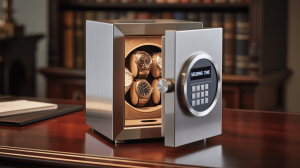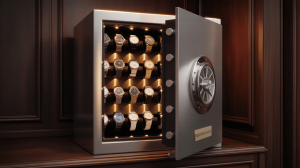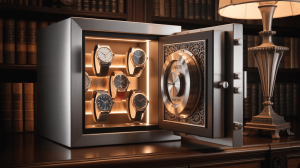Safe for Watches: Combining Security with Elegance. But here’s the kicker… You can have a vault that looks as refined as your timepieces while keeping them guarded against theft, fire, and the elements.
1. Understanding the Importance of a Dedicated Watch Safe
A watch-safe merges robust protection with style. Reinforced steel walls resist tampering, while precision locks—be they mechanical dials, electronic keypads, or fingerprint sensors—control access. Concealed anchor points let you bolt the safe into furniture or floors, thwarting removal attempts. Meanwhile, an elegant exterior—matte black, polished veneer, or leather wrap—complements your décor, turning security into a design statement.
| Component | Function | Benefit |
|---|---|---|
| Reinforced Steel | Resist drilling & prying | High physical security |
| Precision Lock | Dial, keypad, or biometric | Tailored access control |
| Anchor Points | Floor, wall, or furniture mount | Prevents removal |
2. Assessing Theft and Burglary Protection
Start by evaluating local crime data and insurance requirements. UL RSC or ETL burglary certifications guarantee tested resistance, typically rated in minutes against various attack tools. Coupling that with time-delay settings on electronic locks or dual‑lock configurations ensures unauthorized users face maximum delay. Elegant watches deserve barriers as sophisticated as they are—choose a safe whose security specs match your valuables’ worth.
3. Fire and Heat Resistance Fundamentals
Even a small fire can ruin delicate watch movements and lubricants. Look for UL 72 Class 350 ratings: 30–60 minutes at 1,200–1,400 °F, or extended ratings for greater protection. Intumescent seals expand under heat to block smoke and flames, while gypsum or ceramic composite interiors slow heat transfer. Balancing these fire‑proofing features with a sleek profile means selecting a safe that protects quietly, without dominating your space.
4. Matching Size and Capacity to Your Collection
Measure your current watches, consider pillow height (1.5–2 inches), and include room for straps, tools, and future acquisitions. Compact sizes (e.g., 6×8×6 inches) hold 2–4 pieces, medium (8×10×8) up to 6, and larger models accommodate 8–10. A snug fit boosts concealment and prevents items from shifting.
| Dimensions (W×D×H) | Capacity (Watches) | Placement |
|---|---|---|
| 6×8×6 in | 2–4 | Nightstand drawer |
| 8×10×8 in | 4–6 | Closet shelf |
| 10×12×8 in | 6–8 | Cabinet or desk |
5. Selecting Exterior Materials and Finishes
Your safe’s outer shell sets its aesthetic tone. Matte powder‑coat finishes resist fingerprints, while stainless steel offers modern sleekness. For a luxurious touch, choose wood veneer panels or leather wraps in custom colors. Ensure all materials are durable—select corrosion‑resistant hardware and concealed hinges for a clean, elegant look.
6. Choosing the Ideal Locking Mechanism
Mechanical dials are battery‑free and reliable. Electronic keypads allow multiple user codes plus time delays. Biometric scanners grant rapid access but need power and occasional re‑enrollment. Dual‑lock systems combine two methods—keypad plus key or biometric plus dial—for layered security. Match your daily usage patterns and willingness to maintain power supplies with the lock type that fits.
7. Integrating Watch Winder Functionality
For automatic watches, built‑in winders keep movements running. Look for adjustable turns‑per‑day (TPD) and directional settings (CW, CCW, or bi‑directional) to match manufacturer specs. Quiet motors under 25 dB won’t disturb your home. Removable winder trays convert to static storage, maximizing versatility.
| Winder Feature | Specification | Advantage |
|---|---|---|
| Adjustable TPD | 650–2,000 turns per day | Matches each watch’s needs |
| Direction Control | CW, CCW, bi‑directional | Prevents overwind |
| Noise Level | < 25 dB | Quiet home or office use |
8. Organizing the Interior for Protection
A well‑organized safe prevents scratches and makes rotation effortless. Use foam or velvet‑lined pillows sized to case diameters. Adjustable trays and removable dividers let you configure the layout for watches, straps, or tools. Hidden pockets under trays store warranty cards or screwdrivers out of sight, yet within reach.
9. Ensuring Climate and Humidity Control
Leather straps and metal movements demand stable environments. IP54‑rated door gaskets block dust and light moisture. Desiccant or silica gel chambers maintain relative humidity below 50%, preventing corrosion and leather cracking. Digital hygrometers onboard some models offer real‑time readings, while active dehumidifiers provide precise control in humid climates.
10. Balancing Noise and Vibration
Even the best winder is distracting if loud. Choose models with rubber‑damped mounts and precision motors rated under 25 dB. Soft‑close hinges prevent door slams, and smooth bolt mechanisms minimize clicks. In bedrooms or home offices, these silent features preserve tranquillity.
| Noise Control | Feature | Benefit |
|---|---|---|
| Dampened Mounts | Rubber motor isolators | Absorbs vibration |
| Low‑Noise Motors | Precision engineered | Under 25 dB |
| Soft‑Close Hinges | Hydraulic closure | Eliminates slamming |
11. Incorporating Smart Connectivity
Modern safes send tamper and door‑open alerts via Bluetooth or Wi‑Fi to your smartphone. Apps allow remote lock/unlock, TPD adjustments, and audit log reviews—enhancing security whether you’re home or away. Battery‑status notifications prevent unexpected shutdowns of biometric or electronic locks.
12. Evaluating Power and Backup Options
Electronic locks and winders need reliable power. Seek dual‑power designs: AC adapters for continuous use and rechargeable battery packs for emergencies. Low‑battery indicators or app alerts keep you informed. Always have a hidden manual override key or mechanical dial to ensure access if electronics fail.
13. Matching Décor and Style
Your watch safe should complement its surroundings. Matte finishes suit minimalist interiors, while wood veneers or leather wraps add warmth. Custom colors or panel inserts let you match cabinetry or furniture, transforming your safe into a design focal point rather than an eyesore.
| Style Option | Visual Impact | Integration |
|---|---|---|
| Matte Black | Modern minimalist | Blends with tech |
| Wood Veneer | Warm, classic | Complements furniture |
| Leather Wrap | Rich texture | Enhances luxury feel |
14. Budgeting for Value
Safes range from entry‑level ($100–$300) for basic steel shells and key locks, to mid‑tier ($300–$700) adding fire ratings and electronic keypads, to premium ($700+) offering biometrics, smart features, and luxury finishes. Prioritize must‑have certifications and interior needs before optional extras like décor or connectivity.
15. Verifying Warranty and Support
A strong warranty reflects manufacturer confidence. Look for 2–5 year coverage on both safe structure and electronics. Onsite service options, spare part availability, and responsive customer support simplify repairs. Read user reviews about service experiences to ensure reliable after‑sales care.
Conclusion
A watch safe that merges security with elegance protects your collection while enhancing your décor. Ready for the good part? Use this guide to select a safe with certified protection, refined materials, thoughtful interiors, and optional smart features—because safeguarding your watches should be as stylish as they are valuable.
FAQ
Q1: What burglary rating should I choose?
Aim for UL RSC or ETL standards, which provide verified forced‑entry resistance.
Q2: How often replace desiccant packs?
Every 6–12 months, depending on local humidity.
Q3: Are biometric locks secure?
Yes—premium scanners include encrypted templates and backup keys.
Q4: Do smart features require subscriptions?
Basic app control is free; advanced monitoring may involve fees.
Q5: Is professional installation necessary?
DIY anchoring to studs suffices—ensure you follow manufacturer guidelines.







